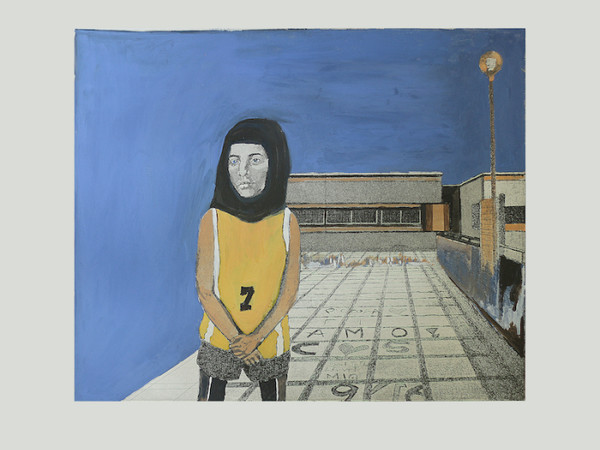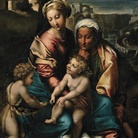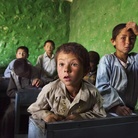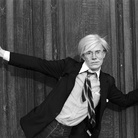Jose Witteveen. Street Gods & Divine Sinners

Jose Witteveen, Laila
From 13 Aprile 2018 to 21 Aprile 2018
Rome
Place: Parione9 Gallery
Address: via di Parione 9
Times: Tuesday to Saturday 02-08pm; Sunday 04-08pm
Responsibles: Marta Bandini, Elettra Bottazzi
Ticket price: free entrance
Telefono per informazioni: +39 0645615644
E-Mail info: parione9@gmail.com
Official site: http://www.parione9.com
On April 13th Parione9 Gallery presents Jose Witteveen’s solo show: Street Gods and Divine Sinners. In the last years, the Dutch artist has dedicated her work to the eternal city of Rome through portraits of its streets and people.
Street Gods and Divine Sinners is Jose Witteveen’s first solo show in Italy, curated by Marta Bandini and Elettra Bottazzi, on display at Parione9 Gallery from April 13th to May 20th 2018.
Jose’s work converts melancholic and cruel landscape’s emptiness into mythical stories, based on memory, reality and fiction.
Mankind’s primitive and animal behavior is very important for her, especially in its attempts to "disguise” its hidden desires. Through the use of etching, her favorite techinique, these themes are present in her recent work, a portrait series of Rome streets and people.
Etching was the first indirect technique in cable and the most used medium by ancient and modern artists.
Its origins can be traced in the Middle Ages, when the nitric acid was employed to engrave friezes and decorations on weapons and armors. Its use was particularly popular among the engravers, especially between the end of the 15th and the beginning of the 16th century.
In this period Rome became the favourite destination for pilgrimages and several foreign artists from the Flanders and Netherlands took long trips to Italy. Transalpine painters, like Albrecht Dürer and Marteen Van Heemskerck, had to deal with a vast and varied heritage of artistic models, having the chance to study archaeological finds and Renaissance masters.
The publishing industry and its volumes, accompanied by engravors’ etchings, created the occasion to spread classical history throughout Europe and beyond. However, other scholars and humanists voices tried to describe some unusual aspects of life in Italy and Rome in the 16th century, such as Karel Van Mander.
Jose Witteveen reveals Rome as a contemporary city but strongly linked to its ancient and glorious past. She analizes the man who live in it: a human being guided by fear and his demons, by lust and his desires; terrorized by death and social emancipation, in a neverending search to satisfy his needs, as an armed soldier able to manage his insecurities.
The artist meet these people by chance, walking around the streets, clashing with their demons and gods, observing their hopes and fears.
The result of her work is a series of engravings guided by words in order to capture the passenger "who walks the streets of Rome".
José Witteveen studied at the Royal Academy of Art in The Hague. Since 2004, she works full-time in Leeuwarden, gratefully using the facilities of the Grafisch Atelier Friesland (Graphic Studio Friesland). Every now and then she leaves this home base for work periods in Berlin, Edinburgh or Reykjavík. From 2016 she live in Rome and collaborate with Parione9 gallery.
Parione9 Art Gallery is a young art gallery in the heart of Rome. It was founded in 2014 by Marta Bandini and Elettra Bottazzi, with the aim to create an innovative space to promote art with an innovative approach to the world of Illustration and Tattoo Art.
Street Gods and Divine Sinners is Jose Witteveen’s first solo show in Italy, curated by Marta Bandini and Elettra Bottazzi, on display at Parione9 Gallery from April 13th to May 20th 2018.
Jose’s work converts melancholic and cruel landscape’s emptiness into mythical stories, based on memory, reality and fiction.
Mankind’s primitive and animal behavior is very important for her, especially in its attempts to "disguise” its hidden desires. Through the use of etching, her favorite techinique, these themes are present in her recent work, a portrait series of Rome streets and people.
Etching was the first indirect technique in cable and the most used medium by ancient and modern artists.
Its origins can be traced in the Middle Ages, when the nitric acid was employed to engrave friezes and decorations on weapons and armors. Its use was particularly popular among the engravers, especially between the end of the 15th and the beginning of the 16th century.
In this period Rome became the favourite destination for pilgrimages and several foreign artists from the Flanders and Netherlands took long trips to Italy. Transalpine painters, like Albrecht Dürer and Marteen Van Heemskerck, had to deal with a vast and varied heritage of artistic models, having the chance to study archaeological finds and Renaissance masters.
The publishing industry and its volumes, accompanied by engravors’ etchings, created the occasion to spread classical history throughout Europe and beyond. However, other scholars and humanists voices tried to describe some unusual aspects of life in Italy and Rome in the 16th century, such as Karel Van Mander.
Jose Witteveen reveals Rome as a contemporary city but strongly linked to its ancient and glorious past. She analizes the man who live in it: a human being guided by fear and his demons, by lust and his desires; terrorized by death and social emancipation, in a neverending search to satisfy his needs, as an armed soldier able to manage his insecurities.
The artist meet these people by chance, walking around the streets, clashing with their demons and gods, observing their hopes and fears.
The result of her work is a series of engravings guided by words in order to capture the passenger "who walks the streets of Rome".
José Witteveen studied at the Royal Academy of Art in The Hague. Since 2004, she works full-time in Leeuwarden, gratefully using the facilities of the Grafisch Atelier Friesland (Graphic Studio Friesland). Every now and then she leaves this home base for work periods in Berlin, Edinburgh or Reykjavík. From 2016 she live in Rome and collaborate with Parione9 gallery.
Parione9 Art Gallery is a young art gallery in the heart of Rome. It was founded in 2014 by Marta Bandini and Elettra Bottazzi, with the aim to create an innovative space to promote art with an innovative approach to the world of Illustration and Tattoo Art.
SCARICA IL COMUNICATO IN PDF
COMMENTI

-
 Dal 31 gennaio 2024 al 04 maggio 2025
Fermo | Palazzo dei Priori
Dal 31 gennaio 2024 al 04 maggio 2025
Fermo | Palazzo dei Priori
-
 Dal 20 dicembre 2024 al 04 maggio 2025
Fermo | Palazzo dei Priori
Dal 20 dicembre 2024 al 04 maggio 2025
Fermo | Palazzo dei Priori
-
 Dal 20 dicembre 2024 al 04 maggio 2024
Gorizia | Palazzo Attems Petzenstein
Dal 20 dicembre 2024 al 04 maggio 2024
Gorizia | Palazzo Attems Petzenstein
-
 Dal 18 dicembre 2024 al 18 dicembre 2024
Venezia | Museo Correr
Dal 18 dicembre 2024 al 18 dicembre 2024
Venezia | Museo Correr
-
 Dal 14 dicembre 2024 al 02 marzo 2025
Palermo | Palazzo Abatellis
Dal 14 dicembre 2024 al 02 marzo 2025
Palermo | Palazzo Abatellis
-
 Dal 12 dicembre 2024 al 23 febbraio 2025
Roma | Palazzo Altemps
Dal 12 dicembre 2024 al 23 febbraio 2025
Roma | Palazzo Altemps


